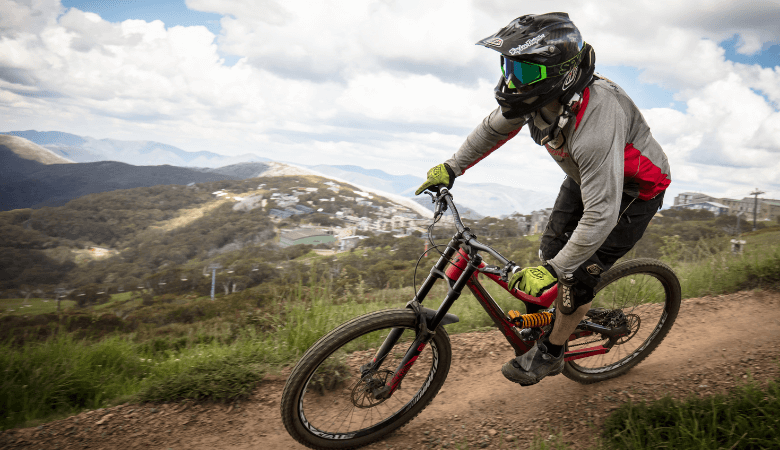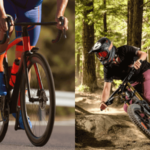How To Gain Confidence Mountain Biking: Mountain biking is an exhilarating sport that can be enjoyed by people of all ages and abilities. However, it can also be a bit daunting for those who are new to the sport or who lack confidence in their riding skills. If you’re looking to gain confidence in mountain biking, there are a few things you can do to build your skills and become more comfortable on the trails.
One of the best ways to gain confidence in mountain biking is to take a skills course or participate in a group ride with experienced riders. This will give you the opportunity to learn some basic techniques and practice them in a safe and controlled environment. You’ll also get the chance to meet other mountain bikers and learn from their experience.
Another great way to build your confidence is to start small and work your way up. Choose trails that are within your skill level and gradually challenge yourself as you become more comfortable with riding on different types of terrain. Don’t be afraid to walk sections of trail that are too difficult or technical for you; everyone has to start somewhere!
With a little practice and patience, you’ll be confident mountain biking in no time. Just remember to always ride within your abilities, start slow, and have fun!
- Start by practicing in an area with little to no traffic
- This will help you get used to riding in different conditions and increase your confidence
- Join a mountain biking group or club
- This will allow you to meet other riders and learn from their experience
- Attend a mountain biking event or race
- This will give you the opportunity to see how other riders handle different situations and also push yourself to ride faster and harder
- Get involved in the mountain biking community online
- There are many forums and websites dedicated to mountain biking where you can ask questions, find trail information, and connect with other riders from around the world
How Do I Gain Confidence When Cycling?
If you’re new to cycling, or have been riding for a while but don’t feel confident on the roads, these tips will help you build your confidence and become a more confident rider.
1. Get to know your bike Before you head out on the road, make sure you know how your bike works and what all the different parts are for. This will help you feel more comfortable and confident when riding, as you’ll know how to fix any minor problems that may occur while out riding. If possible, take your bike to a professional mechanic to get it serviced before hitting the road.
2. Start slow Don’t try to do too much too soon – start with short rides in familiar surroundings before venturing further afield. Once you’ve built up some confidence and fitness, gradually increase the distance and difficulty of your rides. Remember that there’s no rush – take your time and enjoy the process!
3. Join a group ride or class Riding with others can be really enjoyable and is often less daunting than riding alone. There are often group rides aimed at beginners which are a great way to ease yourself into cycling in traffic. If there aren’t any groups in your area, consider joining an organized cycle class at a local gym or studio.
These classes usually include plenty of guidance and support from experienced riders and instructors. Joining forces with other cyclists will also motivate you to keep improving! just remember to listen to your body – if something feels wrong or uncomfortable, stop immediately!
4. Take some Traffic Skills 101 classes Most cities offer beginner-friendly bicycling classes that teach basic street skills like proper hand signals, scanning for hazards, and lane positioning – things that give many people pause when they think about biking in traffic. Check Google , Craigslist, Meetup , or Facebook Groups for offerings near you .
5. Ride during daylight hours At first, limit yourself to daytime riding wh6..en visibility is best. As dusk approaches, it can be harder for drivers to see bicyclists, so it’s important to wear bright clothing and have front and rear lights on your bicycle.
6. You might also want to avoid heavily trafficked streets until you gain more experience.
How Can I Get Motivated for Mountain Biking?
Assuming you would like tips on how to become motivated for mountain biking, here are a few things that may help:
1. Set Some Goals It can be helpful to set some goals for yourself related to mountain biking. This could involve setting a goal to ride a certain number of times per week or month, or it could be a goal related to improving your skills and abilities on the bike. Having specific goals in mind can help give you something to work towards and make mountain biking more enjoyable and rewarding.
2. Find A Riding Partner Another great way to become motivated for mountain biking is to find someone else who enjoys riding as well. This could be a friend, family member, or even just another rider you meet out on the trails. Riding with someone else can make the experience more fun and enjoyable, and it can also push you to ride more often and improve your skills.
3. Join A Mountain Biking Club Or Group Joining an organized mountain biking club or group is another excellent way to get motivated for riding. These groups usually offer regular rides, clinics, and other events which can help riders stay active and improve their skills.
Additionally, being part of a group can provide a great social outlet and a sense of community, both of which can help keep riders coming back for more rides.
How Do You Regain Confidence After a Mountain Bike Crash?
If you’ve recently had a mountain bike crash, it’s normal to feel shaken up and lose some confidence. Here are a few tips to help you get back on track:
1. Review your riding technique. Sometimes we can get sloppy with our riding technique without realizing it, and this can lead to crashes. Take some time to review basic mountain biking skills like cornering, braking, and body position. This will help you fine-tune your technique and avoid future crashes.
2. Get back in the saddle as soon as possible. The longer you wait to get back on your bike, the harder it will be mentally to overcome your fears. Get out there and ride slowly at first if you need to, but challenge yourself to gradually push harder and go faster.
3. Talk to other riders who have experienced crashes. It can be helpful to talk to someone who has gone through a similar experience and come out the other side successfully. They can offer valuable insights and encouragement that will help you boost your confidence again.
How Do I Get Over My Fear of Mountain Biking Jumps?
Mountain biking jumps can be an exhilarating experience. But for some, the thought of launching themselves off a dirt mound or small cliff can be downright scary. If you’re one of those people who get butterflies in your stomach just thinking about hitting the trails, here are a few tips to help you overcome your fear and enjoy the ride.
- Start small. Don’t try to tackle a huge jump right off the bat. Work your way up gradually by starting with smaller jumps and working your way up.
- Ride with someone who’s experienced. If you know someone who’s comfortable mountain biking jumps, ask them to come along with you on your first few rides. They can offer guidance and support while you’re getting used to the sensation of jumping.
- Visualize success. Before attempting a jump, close your eyes and visualize yourself making it safely over the jump without any hesitation or fear. This positive visualization will help increase your confidence when it comes time to take the leap in real life.
- Use proper form. When you’re ready to tempt a jump, make sure you’re using the proper form. This means keeping your body upright and relaxed, keeping your weight balanced, and pedaling evenly as you approach the lip of the jump. Once you’ve left the ground, stay focused on where you want to land and keep pedaling until you reach it.
- Stay positive. It’s normal to feel some nerves before attempting a jump, but try not to let those nerves turn into negative thoughts that will hold you back. Stay positive and remind yourself that you can do this!
How to Hit Drops on a Mountain Bike
Drops are one of the most fun and challenging features you can encounter on a mountain bike trail. They are also one of the most intimidating, especially if you’re new to mountain biking or don’t have much experience with drops. But don’t worry, with a little practice and some helpful tips, you’ll be hitting drops like a pro in no time!
Here are some things to keep in mind when tackling drops:
1. Approach the drop at the right speed. This will vary depending on the size of the drop and how comfortable you feel riding it.If you’re not sure, err on the side of caution and approach it a bit slower than you think you need to. You can always go faster next time!
2. Stay loose on your bike. As you approach the drop, resist the urge to tense up. Instead, stay relaxed and let your body move with the bike. This will help absorb any impact when you land.
3. Keep your weight balanced. When dropping into a hole or off of a ledge, make sure your weight is evenly distributed between the front and back tires by shifting slightly forward or backward as needed. This will help prevent either tire from losing traction mid-drop.
Beginner Mountain Bike Techniques
When it comes to mountain biking, there are a few key techniques that all beginner riders should master before hitting the trails. Here are four essential mountain bike techniques for beginners:
1. Braking One of the most important things to learn when mountain biking is how to brake properly. When braking on dirt or gravel, you want to use your front brake first and then apply pressure to your rear brake as needed. This will help you avoid skidding or losing control of your bike.
On steep descents, it’s also important to keep your weight shifted toward the back of the saddle so that you don’t go flying over the handlebars!
2. Cornering Cornering is another crucial technique for mountain bikers. When approaching a turn, slow down and then lean your bike into the turn while keeping your body upright. As you exit the turn, pedal hard to maintain your momentum. Practice this technique on gentle turns first before tackling more difficult ones.
3. Climbing hills can be one of the most challenging aspects of mountain biking, but it’s important to know how to do it properly in order to avoid getting stuck or exhausted halfway up a hill! When climbing, keep your body positioned over the center of the bike and pedal at a steady rhythm – no standing up out of the saddle!
If you need a little extra help, make use of gears by shifting into lower gear before starting up the hill. And always remember to save some energy for the descent!
How to Improve Mountain Biking Skills
Are you a mountain biking enthusiast looking to take your skills to the next level? If so, then you’ve come to the right place! Here are five tips on how to improve your mountain biking skills:
- Get comfortable with your bike. This may seem like a no-brainer, but it’s important to feel comfortable and confident on your bike before tackling tougher trails. Spend some time riding on easier terrain to get a feel for your bike and how it handles.
- Practice, practice, practice. The more you ride, the better you’ll become at mountain biking. So get out there and hit the trails as often as you can! You’ll soon find yourself becoming more confident and skilled with each ride.
- Pay attention to your form. As with any sport, proper form is key to performing well and avoiding injury. When mountain biking, be sure to keep your body upright and balanced over the bike frame. Also, don’t forget to use those all-important core muscles when going uphill or downhill!
- Be prepared for anything. Mountain biking can be unpredictable, so it’s important to always be prepared for whatever Mother Nature (or the trail) throws at you. This means carrying plenty of water and snacks, wearing appropriate clothing and helmets, and knowing your limits—don’t push yourself beyond what you’re physically able or comfortable doing.
- Have fun! At the end of the day, remember that mountain biking is supposed to be fun! Don’t take yourself too seriously and try not to get too frustrated if things don’t go perfectly every time—just enjoy being out on the trails and exploring as much as you can!
How to Do Big Drops on a Mountain Bike
Many mountain bikers enjoy the thrill of doing big drops on their bikes. Drops can range from a few feet to over 20 feet, and they can be very exhilarating. If you’re interested in trying out some big drops, there are a few things you need to keep in mind.
First, make sure you have a bike that is up for the challenge. A full-suspension bike with at least 6 inches of travel is ideal. You’ll also want to make sure your tires are inflated properly – too much pressure will make them more likely to puncture, while too little pressure will make them more likely to roll off the rim.
Second, choose your drop carefully. Start with something that isn’t too big or gnarly, and work your way up as you become more comfortable with the process. Make sure the landing area is clear of any obstacles, and try to land in the middle of it so you don’t roll off to the side.
Third, once you’re ready to go, approach the drop slowly and deliberately. Lean back slightly as you ride down so your body weight is shifted rearward, and use your arms and legs to absorb any shocks as you land. Stay loose on the bike and let it do its thing – if you tense up, you’re more likely to crash.
With these tips in mind, big drops can be a blast! Just remember to start small and work your way up as you become more comfortable with the process.
Drop Offs Mountain Biking
Mountain biking is a great way to get some exercise while enjoying the outdoors. However, it can be dangerous if you don’t know what you’re doing. That’s why it’s important to be familiar with the proper techniques for drop-offs before hitting the trails.
Here are some tips to help you safely navigate drop-offs on your mountain bike:
1. Approach the drop-off at a slow speed and check out the landing area before committing to the jump.
2. When dropping off, keep your body weight centered over the bike and use your arms and legs as shock absorbers.
3. Land with your wheels parallel to each other and absorb the impact with your legs bent. Avoid braking or pedaling immediately after landing.
4. As you ride down the trail, keep an eye out for other obstacles that could cause problems, such as rocks or roots in the way.
Mountain Bike Red Trail
Mountain biking is a great way to get outside and enjoy the fresh air. There are many different trails to choose from, each with its own difficulty level. The red trail is one of the more difficult ones, but it is also one of the most rewarding.
This trail is located in the mountains, so it has plenty of elevation changes and rocky sections. You need to be careful on this trail, as there are many tree roots and rocks that can trip you up if you’re not paying attention. But if you take your time and enjoy the scenery, you’ll have an incredible experience.
Mountain Bike Beginner Mistakes
Mountain biking is an awesome way to get outside and explore the trails. However, if you’re new to the sport, there are a few things you should avoid doing in order to stay safe and have a good time. Here are four mountain bike beginner mistakes to avoid:
- Not Wearing a Helmet This one is non-negotiable. Always wear a helmet when riding your mountain bike, no matter how short or easy the trail may be. A fall on even a small hill can cause serious head injuries, so it’s not worth taking the risk. Plus, helmets are required by law in some states and provinces.
- Not Checking Your Bike Before Riding Before heading out on the trails, it’s important to do a quick check of your bike to make sure everything is in working order. This includes checking the brakes, tires, chains, and gears. It only takes a few minutes to do but could save you from having a mechanical issue while out on the trail.
- Going Out Too Fast or Too Slow One common mistake that beginners make is either going too fast for their skill level or too slow. If you go too fast, you risk losing control and crashing; however, if you go too slow, you’ll likely get bored quickly as mountain biking can be quite strenuous at times. Find a happy medium pace that challenges you but doesn’t push you beyond your comfort zone.
Downhill Mountain Bike Beginner Tips
Downhill mountain biking can be an intimidating sport, but it is also one of the most exhilarating. If you are a beginner, here are some tips to help you get started:
1. Choose the right bike. There are many different types of mountain bikes, and each has its own strengths and weaknesses. Do your research to find the best bike for your specific needs.
2. Get fitted for a helmet and other safety gear. This is non-negotiable – downhill mountain biking is a dangerous sport and you need to protect yourself as much as possible. A good helmet will go a long way in keeping you safe
3. Learn the basics of bike maintenance. You don’t want to be stranded out on the trail with a flat tire or broken chain. Knowing how to fix common problems will save you a lot of headaches (and money).
4. Start slowly and build up your skills gradually. Downhill mountain biking is not something you can just jump into – it takes time and practice to master the skills necessary for riding safely and effectively down steep, technical trails. Start by riding easy trails close to home before venturing out into more challenging terrain.
5. Join or participate in organized rides or events. There are often group rides or events specifically for beginners that can help you learn from more experienced riders while meeting others who share your interests.
Conclusion
Mountain biking takes practice and skill, but once you master the basics, it can be an incredibly fun and freeing experience. To help you gain confidence on the trails, we asked our mountain biking experts for their top tips. Start small: Choose a trail that is within your skill level and work your way up from there.
Don’t be afraid to walk sections of the trail if you need to. Ride with friends: There’s strength in numbers! Not only will riding with friends give you moral support, but they can also offer helpful tips and advice.
Get fitted for your bike: Make sure your bike is properly sized and adjusted for you. This will help you feel more comfortable and in control while riding. Practice, practice, practice: The more time you spend on your bike, the better you’ll become at handling different terrain and obstacles.









2 thoughts on “How To Gain Confidence Mountain Biking”